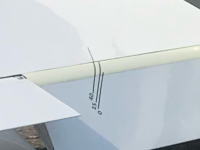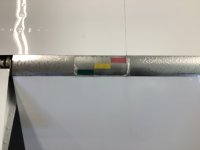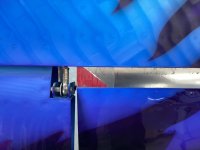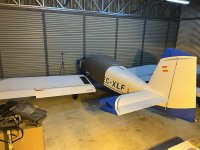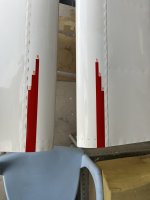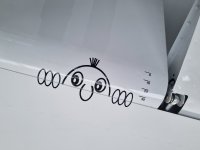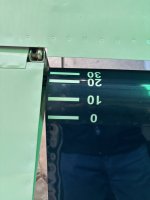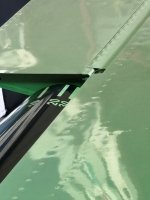Van's Air Force
You are using an out of date browser. It may not display this or other websites correctly.
You should upgrade or use an alternative browser.
You should upgrade or use an alternative browser.
Flap Extension Labeling
- Thread starter 77bonanza
- Start date
I have seen it before but don't remember where exactly. Great idea and totally forgot about it. I have brother p-touch labels all over the side of the canopy. Probably the largest clear with opposite colour print would work great. The labels have stayed on very well for over a year.
D-Dubya
Well Known Member
I have a small vinyl sticker (looks like a hyphen, from Fast Signs) on the left flap that is even with the trailing edge of the wing when at half flaps. It's nothing fancy, just a quick visual verification. My plane has the Showplanes flap positioning system, so it has stops at quarter, half and full. Quarter flaps is pretty easy to identify, and full flaps is obvious. For me, half flaps is the one that was hardest to tell at a quick glance, and that's the one I usually land with. Yeah, yeah, people can dog pile that comment and say every landing should be full flaps, but that's what gives me the most consistent smooth landings. If I'm on a short strip, I'll go full flaps.
planenutz
Well Known Member
Absolutely - and it works very well. In fact I tend not to use the cockpit indication at all and out of habbit simply glance out at the flap position. I had our local signwriting shop make up the vinyl drawing and I applied it myself. In my case it took a bit of planning to get it not only sized right but also located right too. I have the flap positioning system with detents at 10, 20, 30 and 40 degrees.
I tried to attach a short video however it was too large so I've enlarged a corner of a photo instead. I apologise for the grainy picture. I'll try and get a better picture next time I'm at the hangar.
When you can see Kilroy's hair, you have 10 degrees, when you can see the top of his head you have 20 degrees, when you can just see his eyes you have 30 and when you can see all of him you have 40 degrees. I get a lot of comments about him but best of all its funny to watch him appear as the flaps go out. Cheap entertainment for my simple mind.
I tried to attach a short video however it was too large so I've enlarged a corner of a photo instead. I apologise for the grainy picture. I'll try and get a better picture next time I'm at the hangar.
When you can see Kilroy's hair, you have 10 degrees, when you can see the top of his head you have 20 degrees, when you can just see his eyes you have 30 and when you can see all of him you have 40 degrees. I get a lot of comments about him but best of all its funny to watch him appear as the flaps go out. Cheap entertainment for my simple mind.
Attachments
Last edited:
Toobuilder
Well Known Member
Isn’t it easier to simply compare the deflection against the aileron?
planenutz
Well Known Member
Only when you're straight and level.Isn’t it easier to simply compare the deflection against the aileron?
Toobuilder
Well Known Member
If you are displacing the ailerons in the pattern enough to make it difficult to compare to flap deployment, then you probably don’t need to worry about the specific deflection of your flaps.Only when you're straight and level.
planenutz
Well Known Member
If you are displacing the ailerons in the pattern enough to make it difficult to compare to flap deployment, then you probably don’t need to worry about the specific deflection of your flaps.
This is true.
In fact if we were honest I don't really need any indication system, because each activation of the flap switch gives me 10 degrees so I only need to count switch taps. I have four fingers so I can count to at least four (although like most pilots I can't count past 10 unless I take my socks off).
But I would rather have Kilroy. If for no other reason than "because i can".
Don't be a kill-joy for my Kilroy!
Dugaru
Well Known Member
Hilarious! This is the content I am here for.When you can see Kilroy's hair, you have 10 degrees, when you can see the top of his head you have 20 degrees, when you can just see his eyes you have 30 and when you can see all of him you have 40 degrees.
Toobuilder
Well Known Member
My apologies... I do flight test for a living and sometimes the humor gets overshadowed by practicality.…Don't be a kill-joy for my Kilroy!
for the record, I like your Kilroy!
I spoke to an owner at OSH one year who had a very nice visual indication of his exact flap position so I asked him about it. He said it turned out to be a waste of time, since he could tell flap position by the number of seconds on the flap switch, and glancing out the window. His experience matches mine.Isn’t it easier to simply compare the deflection against the aileron?
I personally use 3 positions:
- Up
- About half
- Full
Desert Rat
Well Known Member
This seems really easy until I recall how miserably I fail at this concept when I go looking for that elusive 7th gear on pretty much every motorcycle I've ever owned....I don't really need any indication system, because each activation of the flap switch gives me 10 degrees so I only need to count switch taps....
planenutz
Well Known Member
On our Bolkow Monsun the electric flaps have an old round factory-fitted steam gauge. It sticks in the "up" position. When you select flaps at about 15 degrees for take-off you first count "potatoes" (approximately 1.5 seconds) then check the black mark on the flap is visible. Finally you give the gauge a flick with your finger and the needle drops to around the 15 degree mark every time. So yes, I'm fully conversant with all the methods available... from counting the travel time, looking and comparing the flap angle to the aileron, using the simple black mark on the flap. And yes, at the end of the day it doesn't really matter whether the flaps are at 10 degrees, 12 degrees or 15 degrees. Nobody is checking your accuracy and only you know if you got it right or got it wrong - this time. So in all seriouslness, I understand the point of view presented above by those asking "why?".
Still not removing Kilroy though.
Still not removing Kilroy though.
Scott Hersha
Well Known Member
Me too. When my flap handle is in the middle notch, I’m at half flaps. When the lever is up in the top notch, I’m at full flaps. Very precise, and it always works - without fail.For my manual flaps, I just use my hand to feel and figure out how many notches I have out.
I took a couple of pics when at the hangar earlier today, one from behind the wing, one from the cockpit. Credit to the builders, these have served me well, except as others have noted, on night flights. For those, I made a little Excel table of times for all of the extension transitions I might want to make, e,g. reflex-0; reflex-10 (takeoff, downwind after point abeam), aas well as LPV/ILS approaches from GS intercept [lowers the nose a bit, and controls feel a less sloppy]); 0-10 (similar to above, if I'm already out of reflex); and 10-20. Don't need times for full extension of course, as they hit the stops. Similar table for raising them--30-10 and 20-10, for go-arounds and TnGs. Ran them several times, and the "one-one thousand, two-one thousands" were very close. Printed the table, relatively large font (16) to make it easier to read at night, and placed it in the checklist binder as a separate page.
Attachments
FWIW,
I flew 100 hours without. Like Mickey said, I used UP, about Half or Full.
Because it's 0$, electric tape strips, I installed these. Two styles: ladder on one side and steps on the other.
10 - 20 - 30 degrees.
Is it useful ? Not that much but they're there if I want to know. Easy to see from the front seat.
Still can't say which style I prefer or which is easier to read.
(When the FWD edge of the tape is equal to the wing skin, that's when the flap angle is set)
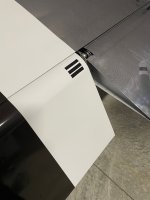
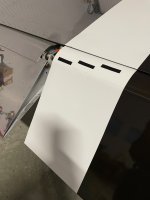
I flew 100 hours without. Like Mickey said, I used UP, about Half or Full.
Because it's 0$, electric tape strips, I installed these. Two styles: ladder on one side and steps on the other.
10 - 20 - 30 degrees.
Is it useful ? Not that much but they're there if I want to know. Easy to see from the front seat.
Still can't say which style I prefer or which is easier to read.
(When the FWD edge of the tape is equal to the wing skin, that's when the flap angle is set)


Toobuilder
Well Known Member
I liked the simplicity of my L39 - 3 buttons:
Up
Takeoff
Land
Up
Takeoff
Land
Flyingnorth
Member
2 short grease pencil lines at 1/3 and 2/3 flaps. Touched up maybe twice in 14 years.
Flyingnorth
Member
Roger that
I cannot imagine that anyone is not using the reflex position. After all, that’s the configuration that gives the most speed, at least down low.Are people using/marking the reflexed position?



